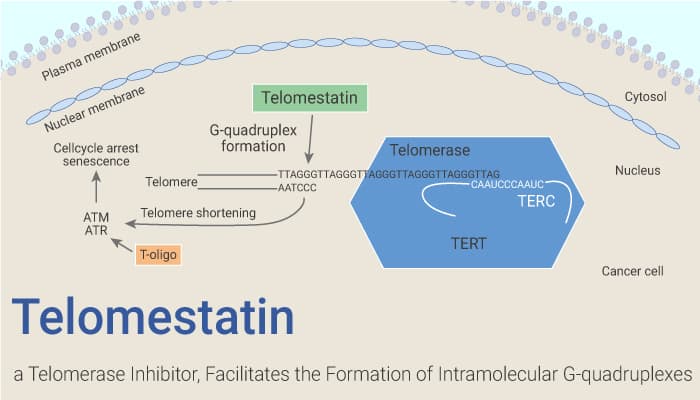Telomestatin is a very potent telomerase inhibitor and can be isolated from Streptomyces anulatus 3533-SV4. It selectively facilitates the formation of intramolecular G-quadruplexes, in particular, that produced from the human telomeric sequence d[T2AG3]4.

Firstly, in vitro, Telomestatin promotes or stabilizes the formation of the intramolecular G-quadruplex. When the DNA concentrations are at 0.005 and 0.2 µM, the EC50 values are 0.03 µM and 0.53 µM, respectively. In a parallel experiment with the mutated oligonucleotide d[T2AGAG]4, there is no conversion of the mutated sequence to a G-quadruplex structure by telomestatin.
Telomestatin, a Potent Telomerase Inhibitor, Facilitates the Formation of Intramolecular G-quadruplexes.
Telomestatin affects the expression of DN-hTERT on telomerase activity and telomere length. At 10 μM,the expression of DN-hTERT shows a significant reduction of telomerase activity. Additionally, in U937 cells, at 2 μM, the terminal restriction fragment (TRF) length of U937 cells shortens progressively from 9.5 to 3.8 kb at population doubling (PD).
This compound has less effect on normal diploid human fibroblasts and ALT-positive cells. Telomestatin exposure has no effect on the viability of normal human fibroblasts BJ or IMR-90. However, 5 μM of telomestatin reduces the viability of GM847 cells.
Telomestatin does not significantly change the proliferation rate or viability to that of control cells in BJ or IMR-90 cells and also does not change the proliferation of GM847 cells.
In mice model with U937 xenografts, Telomestatin is administrated by intraperitoneal injection at 3-15 mg/kg for 4 weeks. There exhibit no adverse effects, including bodyweight loss, clinical signs, or survival. It decreases tumor telomerase activity and inhibits the growth of U937 xenografts.
Systemic administrations of 3 mg/kg or 9 mg/kg or 15 mg/kg of Telomestatin decreases tumor telomerase activity by 60.2%, 74% and 92.5% compared to control, respectively. PBS treatment results in a mean tumor volume of 1395 mm3, but Telomestatin results in a mean tumor volume of 291 mm3. It also reduces U937 cells in the bone marrow and recovered the normal hematopoiesis in mice.
In conclusion, as a very potent telomerase inhibitor, Telomestatin has anti-cancer effects in vitro and in vivo.
Reference:
[1]. Mu-Yong Kim, et al. J Am Chem Soc. 2002 Mar 13;124(10):2098-9.
[2]. Keita Amagai, et al. Sci Rep. 2017 Jun 13;7(1):3382.